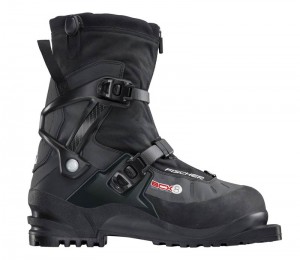Fischer has added some beef to their Nordic ski boot program with their BCX875 boot. This is a 75mm soled boot, aimed at the rugged touring (S-Bound) crowd who like to make a few tele turns while cruising the woods and foothills. It reminds me of a stripped down version of the Merrell SuperComp with a plastic cuff wrapped around a leather boot, except that this boot only provides the structural skeleton of a plastic cuff for enhanced turning power. So the big question is, is it enough? That would depend on what size ski you have.
Being a turn earning telemark skier, the smallest ski in my quiver is Karhu’s Guide (Madshus Annum, Fischer S-Bound 112), with a full 80mm of girth at the waist. The binding was a pair of Burnt Mountain Designs Lite-Dogz, a step-in version of the classic 3-pin design. For comparison, I used a Garmont Excursion on my left foot, the Fischer BCX 875 on my right.Making turns in soft snow was no problem for either boot, but in frozen crud, Fischer’s BCX was a bit underpowered. So was the Excursion, but not as much. I think if I had been using slightly smaller skis, like a pair of S-Bound 98s with a waist width of 69mm, the BCX would have felt right at home. With bigger touring skis, like the S-Bound 112 (waist width @ 78mm), the skeletal cuff needs bigger bones.
But it’s not all about turning power and for that the BCX may deliver a better balance than the all-plastic option. Garmont’s Excursion tours well with 3-pin bindings, and is easier to get in to and cinch down by comparison, but Fischer’s BCX with classic lacing delivers a snugger, more comfortable fit. In addition, the internal boot has a heel adjustment strap to cinch around your heel from the rear and keep your foot locked in the heel pocket.
The BCX875 might even be able to provide more power thanks to the ratcheting straps over the instep and around the cuff, but the material needs to be made of a stiffer, harder material. The ratcheting latches are really nice, but the strap they clamp on to is so soft that as soon as the strap starts to apply serious pressure, the teeth in the strap won’t hold. I found I could cinch the straps tighter by simply pulling on them than I could by ratcheting them. Even then, there is a limit and I wanted to make ‘em tighter, but couldn’t because the material was too soft.
Over time, the leather based BCX is bound to become softer which bodes well for long distance tours. Those who are looking for a system that delivers better touring with adequate turning power may find this boot to be more of what they are looking for, as opposed to the all plastic options from Garmont or Scarpa.
Fischer Sports
BCX875
MSRP: $295
Sizes available: 37 – 49 (Euro sizing), 23 – 30 (mondo sizing)


4 comments
1 ping
Skip to comment form
Any weight?
Best I can give you is an estimate…approx 3.3 lbs per foot. Fischer doesn’t provide those specs on their site, and it’s been a few years since I skied these. My recollection is they were a bit lighter than T2’s, but not a lot.
My new pair (Eur 45) are exactly 3lbs per boot. That is half a pound more per boot than my old Crispi Antartics, which are leather and better walking boots than skiing – the BCX 875 are the opposite, but you can walk in them!
Certainly not a groomers telemark boot – even on the Green slopes I now know what a soft boot feels like. I was trying to drive Scotty Bob Bobtail 168, Burnt Mt Spike binding. The Garmin Gara hard shell I got on eBay, custom foamed liner, work much better on the groomers. When your foot is 26.5 mondo, cm, heel to toe but 28.5 cm heel to heel across the instep, you don’t have much choice in hard shell boots.
For heavy touring, Alpina X Terrain – fishscale base, with Voile cable binding, BCX 875 is a nice boot.
[…] Related Posts Review: Fischer BCX875 […]